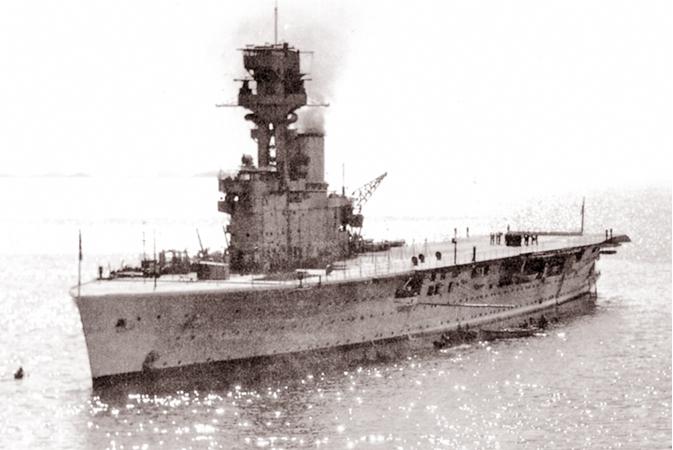
Many Sri Lankans from the ‘Ceylon” vintage will remember the famous Easter Sunday Raid in 1945 when Japanese fighters dive bombed selected targets in Colombo and other locations. The ensuing mayhem was vivid in the mindset of an entire generation. But unknown to many of us there is another magnificent sea battle that is perfect for a Hollywood blockbuster. The world’s first purpose built air craft carrier HMS Hermes was ruthlessly attacked by Japanese bombers off Trincomalee and went down to her watery grave taking her Captain and 307 sailors. For decades their story remains under the mighty ocean.
The super carrier
The Royal Navy commenced building this super vessel during the First World War but the ambitious project was not complete. The massive warship was completed after the war. Her Latin motto read “Altiora Peto- I seek higher things”. Her unique feature was her retractable slipway. She had a length of 600 feet and a beam of 70 feet with a displacement of 10,850 tons. Powered by steam turbines she had a speed of 26 knots. The ship had an armament of six 102 mm guns. This was later updated with 152 mm guns. In addition she had 4 anti aircraft guns on her broad flight deck.HMS Hermes had a crew of 33 officers and 533 sailors. Her first captain was Arthur Stopford.
 Commissioned in 1924 she was attached to the Atlantic Fleet. She was an imposing vessel with her flight deck and was relocated to the Mediterranean Fleet. When the 2 World War began she was deployed to sea tasked with anti submarine patrols. Here she gallantly sunk the French battleship Richelieu by using depth charges and deploying her Swordfish torpedo bombers. During 1932 the vessel had even sailed to Nagasaki, Japan. In 1939 she was refitted and Captain Hutton assumed command. At one stage the Hermes was replicated by a merchant ship SS Mamari, to confuse the enemy. The ship had a wooden flight deck that resembled Hermes and sailed as a phantom ship. In February 1942 HMS Hermes was deployed to the Eastern Fleet and sailed to Ceylon on 4th March.
Commissioned in 1924 she was attached to the Atlantic Fleet. She was an imposing vessel with her flight deck and was relocated to the Mediterranean Fleet. When the 2 World War began she was deployed to sea tasked with anti submarine patrols. Here she gallantly sunk the French battleship Richelieu by using depth charges and deploying her Swordfish torpedo bombers. During 1932 the vessel had even sailed to Nagasaki, Japan. In 1939 she was refitted and Captain Hutton assumed command. At one stage the Hermes was replicated by a merchant ship SS Mamari, to confuse the enemy. The ship had a wooden flight deck that resembled Hermes and sailed as a phantom ship. In February 1942 HMS Hermes was deployed to the Eastern Fleet and sailed to Ceylon on 4th March.
The airborne attack
HMS Hermes strike capability was upgraded with aircraft from 814 Squadron and she was now paired with the destroyer HMAS Vampire and they were tasked with anti submarine patrolling. Vampire had a crew of 6 officers and 113 sailors. The ships were then ordered to sail to Australia but the order was cancelled and they remained in Trincomalee. On 5 April the Japanese bombers pounded targets in Colombo, spreading panic all over the island. In the aftermath of this strategic strike the crews of both ships were getting ready for the invasion of Madagascar codenamed operation Ironclad. Naval intelligence had indicated another wave of Japanese attacks and HMS Hermes sailed out of harbor without her aircraft. A solitary scout plane from the Japanese battleship Haruna spotted the massive ship on 9th April 1942 and radioed her bearings at 10.35 am. This was the day of reckoning that the Japanese bombers were waiting for. They scrambled their flights to kill and destroy.
The radioman of Hermes received a message from naval command to sail back to the safety of Trincomalee harbor. Turning a mammoth ship of this magnitude is no easy task. In the meantime the carrier was being targeted by 85 Japanese Aichi dive bombers and 9 Mitsubishi Zero fighters. The attacking bombers would soon zero in on the vulnerable target. Gunners ran to their action stations to defend their ship. The British dispatched 6 Fulmar fighters from 273 Squadron to provide air support to the ship.
The Fulmar bomber has a speed of 272 miles per hour and was armed with 4 wing mounted machine guns. Another 6 planes from 806 Squadron also joined the counter strike but it was too late. Having being hit 40 times the majestic HMS Hermes sent her distress signals and sank off the Batticaloa coast on grid bearing 7°35′28.392″N 82°05′55.089″E. Captain Richard Onslow and 307 others were sucked into the gushing blood stained waters. In this land away from their own homes they lay buried deep in the ocean, their story submerged in time. The captain of HMAS Vampire was also killed. A few survivors from Hermes were rescued by the ship Vita. I was able to visit the Commonwealth War graves in Trincomalee and see the names of a few sailors possibly from this ship. To date the spot where the warship went down remains a mystery laden dive site.
